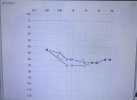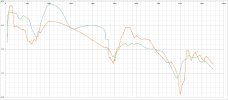I have been wearing hearing aids for over 5 years and my hearing continued to decline with tinnitus blaring in the mornings. Just finished a 45 day trail with Oticon Real and now trying Phonak Audeo Lumity instead. Frustrated that after many fitting sessions with my audiologist, I am still having trouble understanding speech with the new hearing aids giving me not much improvement over my old Oticon OPN miniRites. I am an engineer and wanted to play with the settings myself. So delighted to find this forum with great information. So far, I have purchased the Noahlink Wireless and got it working with Phonak's Target 9.0 software. Looking forward to see if I can do a better job than my audiologist.
PVC, thank you for posting all these great info. Just want to get your feedback with my situation. Here is the audiogram from my audiologist...

I noted that the Bone Loss data is missing for the left side. My audiologist responded that it is not needed as the right BL is very close to the audio loss. What do you think. The Target software kept complaining about it and want to do a rebalance. Not sure what that is.
Despite the many adjustments, I continue to hear voices sound very tinny and hard to understand women with a tinny voice. Their voice comes over distorted to me. I began to suspect that the insertion gain profile is not suitable for me. But my audiologist seem at a loss as to what to do next except to fool around with zooming and compression settings. So, I did a full audiogram myself using an online tone generator and my old overhead wired Sony headphones to see at what volume level I can't hear each frequency for each ear. I was surprised to find my curve to be very different than the audiologist's. In particular, I tested with very small frequency increments and found that I have major peaks and dips over fairly narrow frequency ranges which are invisible at the sparse testing frequencies the audiologist used. Since I have no idea what the overall sound level is, I just shifted the overall level to match the audiologist's data at 4K Hz. I converted the volume level percentage number to dB. Here is what it looks like...

I showed it to my audiologist and she had no idea what she can do with it. Also, my Phonak Audeo Lumity only has 20 tuning ranges and can't handle the small range peaks and dips from my test. We tried to vary the key peak at 5K9 in the Target fitting software's insertion gain table and it drags the gain values in the adjacent frequency ranges with it. So seems like these 20 ranges are not independent of each other.
I am starting to study all your info to learn how to DIY. Would appreciate any guidance and feedback.
Sorry if this is too much details for an intro thread. Let me know and I can start a thread somewhere else.
PVC, thank you for posting all these great info. Just want to get your feedback with my situation. Here is the audiogram from my audiologist...

I noted that the Bone Loss data is missing for the left side. My audiologist responded that it is not needed as the right BL is very close to the audio loss. What do you think. The Target software kept complaining about it and want to do a rebalance. Not sure what that is.
Despite the many adjustments, I continue to hear voices sound very tinny and hard to understand women with a tinny voice. Their voice comes over distorted to me. I began to suspect that the insertion gain profile is not suitable for me. But my audiologist seem at a loss as to what to do next except to fool around with zooming and compression settings. So, I did a full audiogram myself using an online tone generator and my old overhead wired Sony headphones to see at what volume level I can't hear each frequency for each ear. I was surprised to find my curve to be very different than the audiologist's. In particular, I tested with very small frequency increments and found that I have major peaks and dips over fairly narrow frequency ranges which are invisible at the sparse testing frequencies the audiologist used. Since I have no idea what the overall sound level is, I just shifted the overall level to match the audiologist's data at 4K Hz. I converted the volume level percentage number to dB. Here is what it looks like...

I showed it to my audiologist and she had no idea what she can do with it. Also, my Phonak Audeo Lumity only has 20 tuning ranges and can't handle the small range peaks and dips from my test. We tried to vary the key peak at 5K9 in the Target fitting software's insertion gain table and it drags the gain values in the adjacent frequency ranges with it. So seems like these 20 ranges are not independent of each other.
I am starting to study all your info to learn how to DIY. Would appreciate any guidance and feedback.
Sorry if this is too much details for an intro thread. Let me know and I can start a thread somewhere else.

